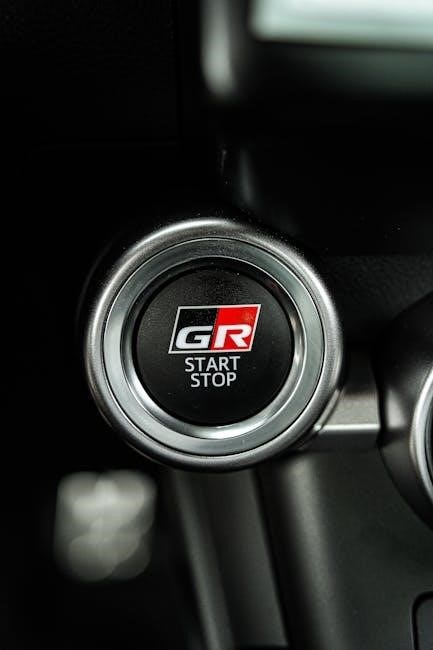Humminbird PiranhaMAX 4 DI Manual: A Comprehensive Guide
This detailed guide provides comprehensive instructions for the Humminbird PiranhaMAX 4 DI, covering installation, operation, and troubleshooting, available in PDF format․
The Humminbird PiranhaMAX 4 DI is a powerful and user-friendly fish finder designed to enhance your angling experience․ This model combines standard sonar with Down Imaging technology, providing a detailed view of the underwater world․ It’s built for both novice and experienced anglers seeking to locate fish and understand underwater structures effectively․

This guide serves as a complete resource, detailing everything from initial setup and calibration to advanced feature utilization․ Whether you’re installing the transducer, navigating the menu system, or interpreting sonar readings, this manual will provide clear, step-by-step instructions․ Access to the PDF manual ensures convenient offline reference․ Understanding its capabilities will unlock a more productive and enjoyable time on the water, maximizing your fishing success with the PiranhaMAX 4 DI․
Key Features and Benefits
The Humminbird PiranhaMAX 4 DI boasts several key features designed to optimize your fishing experience․ DI (Down Imaging) provides photo-like detail of structure beneath your boat, while standard sonar offers broad coverage for locating fish schools․ Fish ID+ technology intelligently identifies fish targets, simplifying interpretation․
Benefits include enhanced fish detection, precise location of underwater structures, and improved overall angling efficiency․ The intuitive menu system and clear display make operation straightforward, even for beginners․ Accessing the comprehensive PDF manual unlocks the full potential of these features․ With its combination of affordability and performance, the PiranhaMAX 4 DI delivers exceptional value for anglers of all skill levels, maximizing success on every trip․

Understanding the Display and Controls

Familiarize yourself with the PiranhaMAX 4 DI’s display, menu navigation, and icons for optimal use; the manual provides detailed explanations․
Powering On and Off
To power on your Humminbird PiranhaMAX 4 DI, simply press and hold the Power button located on the unit’s front panel․ The display will illuminate, initiating the startup sequence and displaying the Humminbird logo․ Allow a few moments for the unit to fully boot up and establish a sonar connection․
To power off the fish finder, press and hold the Power button again until the display shuts down completely․ Avoid abruptly disconnecting the power source while the unit is operating, as this could potentially corrupt stored data or settings․ Always ensure a proper shutdown sequence is followed to maintain the integrity of your PiranhaMAX 4 DI․ Proper powering on and off procedures are crucial for longevity and optimal performance․
Navigating the Menu System
The PiranhaMAX 4 DI utilizes a straightforward menu system, accessed via the directional buttons on the unit’s control panel․ Press the “Menu” button to reveal the main menu options, including Sonar, Setup, and Fish ID+․ Use the Up and Down arrow buttons to highlight your desired menu category, then press “Enter” to select it․
Within each menu, navigate through sub-options using the same directional buttons․ To adjust settings, highlight the parameter and use the arrow buttons to modify the value․ Press “Enter” to confirm your changes․ The “Back” or “Menu” button will return you to the previous menu or the main screen․ Familiarizing yourself with this system unlocks the full potential of your Humminbird․
Understanding the Display Icons
The PiranhaMAX 4 DI display employs various icons to convey crucial information․ A fish icon indicates a potential fish target detected by the sonar, with size correlating to signal strength․ Arc shapes represent fish arches, while individual pixels signify smaller targets or structure․ The bottom contour is displayed as a solid line, indicating depth changes․
Other icons signify features like DI (Down Imaging) mode, signal strength, depth range, and battery voltage․ A flashing icon often indicates an active setting or alert․ Refer to the manual’s icon legend for a complete explanation of each symbol․ Recognizing these icons is vital for accurate interpretation of sonar readings and maximizing your fishing success․

Installation and Setup
Proper installation involves secure transducer mounting, reliable power connection, and precise initial calibration for optimal PiranhaMAX 4 DI performance and accurate readings․
Mounting the Transducer
Secure transducer mounting is crucial for optimal sonar performance․ Select a location ensuring consistent water contact and minimal turbulence․ The PiranhaMAX 4 DI transducer can be transom-mounted, using the included bracket, or through-hull installed, requiring professional assistance․
Ensure the transducer is aligned parallel to the waterline for accurate depth readings․ Avoid mounting near engine outtakes or other obstructions․ Tighten all mounting hardware securely, but avoid over-tightening, which could damage the transducer․
Cable routing is also important; protect the cable from damage by running it through a dedicated cable conduit or securing it with cable ties․ Proper mounting significantly impacts the clarity and reliability of your sonar readings, enhancing your fishing experience․
Connecting to Power
Proper power connection is essential for the Humminbird PiranhaMAX 4 DI’s operation․ This unit typically requires a 12V DC power source․ Ensure your boat’s electrical system provides a stable and regulated 12V supply․ Connect the unit’s power wires – usually red for positive (+) and black for negative (-) – to the corresponding terminals on your boat’s battery or power distribution system․
Always use a fuse in the positive lead, close to the power source, to protect the unit from electrical surges․ Verify correct polarity before connecting; reversed polarity can cause serious damage․
A dedicated power connection is recommended to avoid interference from other onboard electronics․ Secure all connections to prevent corrosion and ensure reliable power delivery during operation․
Initial Setup and Calibration
Upon powering on your Humminbird PiranhaMAX 4 DI, initial setup and calibration are crucial for accurate readings․ Begin by setting the correct date and time within the unit’s menu․ Next, configure the transducer settings, ensuring the depth range and sensitivity are appropriately adjusted for your fishing environment․
Calibration involves verifying the unit’s ability to accurately display water depth․ Compare the displayed depth with a known depth, and adjust the offset if necessary․ Proper calibration optimizes sonar performance and provides reliable fish detection․
Review the unit’s settings to customize display preferences and select preferred units of measurement․ Save these settings to ensure consistent performance across fishing trips․

Using the Fish Finder
Effectively utilize the PiranhaMAX 4 DI by interpreting sonar returns, adjusting settings for clarity, and leveraging the Down Imaging feature for detailed underwater views․
Interpreting Sonar Readings
Understanding the sonar display is crucial for successful fishing․ The Humminbird PiranhaMAX 4 DI presents underwater structures and fish as echoes․ Stronger echoes generally indicate denser objects or those closer to the transducer․ Arches often represent fish, with the peak indicating the fish’s position․ However, interpreting arches requires experience, as they can also be caused by thermoclines or other underwater features․
Pay attention to signal strength and clarity․ A weak or broken signal might indicate insufficient sensitivity settings or interference․ Learn to differentiate between true fish returns and false readings caused by vegetation, bottom clutter, or surface noise․ The depth range setting significantly impacts the detail and clarity of the sonar image; adjust it appropriately for the water depth you are fishing in․ Consistent practice and observation will enhance your ability to accurately interpret sonar readings․
Adjusting Sensitivity and Depth Range
Optimizing the sensitivity and depth range on your Humminbird PiranhaMAX 4 DI is vital for clear sonar returns․ Sensitivity controls the receiver’s ability to detect weak signals; higher settings detect more, but can also amplify noise․ Start with a lower sensitivity and gradually increase it until you achieve a clear image without excessive clutter․

The depth range should be set to slightly exceed the maximum depth you’re fishing․ A narrower range provides greater detail, while a wider range allows you to scan deeper water․ Incorrect settings can result in lost fish or a cluttered display․ Experiment with both settings to find the optimal balance for your specific fishing conditions and water environment․
Utilizing the DI (Down Imaging) Feature
The Down Imaging (DI) feature on your Humminbird PiranhaMAX 4 DI provides incredibly detailed views of structure directly beneath your boat․ Activate DI mode through the menu system, and observe the enhanced clarity of underwater objects like rocks, vegetation, and fish․
Adjust the DI range to match the water depth, similar to standard sonar․ Experiment with the DI sensitivity to optimize image clarity, reducing noise and maximizing detail․ Remember that DI provides a different perspective than traditional sonar, focusing on vertical structure․ Combining both sonar modes offers a comprehensive understanding of the underwater environment, enhancing your fishing success․

Advanced Features
Explore Fish ID+, Virtual Ethernet, and SwitchFire™ technologies, enhancing your Humminbird PiranhaMAX 4 DI experience with innovative features for superior fish finding․
Fish ID+ Technology
Fish ID+ is a remarkable feature on the Humminbird PiranhaMAX 4 DI, designed to simplify fish identification directly on the display․ This advanced technology goes beyond basic fish symbols, offering a more refined and accurate representation of potential targets․ It analyzes sonar returns and categorizes them, displaying fish icons with size indicators, helping anglers quickly assess the size and quantity of fish present․
Unlike standard Fish ID, the “+” version provides enhanced accuracy, reducing false readings and improving the overall reliability of fish identification․ Users can customize the size ranges displayed, filtering out smaller targets or focusing on larger, more desirable fish․ This feature is invaluable for anglers of all skill levels, streamlining the process of locating and targeting fish, ultimately leading to more successful fishing trips․ It’s a powerful tool for interpreting sonar data efficiently․
Virtual Ethernet
Virtual Ethernet functionality, while a more advanced feature typically found in higher-end Humminbird units, may have limited or no direct implementation on the PiranhaMAX 4 DI․ This technology allows for networking between compatible Humminbird devices, enabling data sharing like sonar, GPS, and mapping information․ It essentially creates a private network for enhanced functionality․
If supported, Virtual Ethernet would facilitate seamless integration with other Humminbird fish finders or chartplotters, allowing you to view data from multiple transducers simultaneously or share GPS waypoints․ However, given the PiranhaMAX 4 DI’s simpler architecture, it’s crucial to consult the official manual to confirm its availability and specific implementation details․ Check for Ethernet port presence and network settings within the menu system․
SwitchFire™ Technology
SwitchFire™ Technology is a Humminbird innovation designed to optimize sonar performance for varying conditions․ It allows anglers to quickly switch between two distinct sonar views – a clear, detailed view for calm waters and a maximized target separation view for challenging conditions like rough seas or heavy vegetation․ This adaptability ensures optimal fish detection regardless of the environment․
On the PiranhaMAX 4 DI, SwitchFire™ enhances target identification by dynamically adjusting the sonar’s grayscale palette and signal processing․ Accessing SwitchFire™ typically involves a dedicated menu option or button press, allowing for instant toggling between the two modes․ Experimenting with both settings is key to understanding which provides the clearest picture of the underwater structure and fish, maximizing your fishing success․

Troubleshooting
Common issues, error messages, and factory reset instructions are detailed here to resolve problems with your Humminbird PiranhaMAX 4 DI effectively․
Common Issues and Solutions
Display problems, such as a blank screen or dim image, often stem from power connections or insufficient brightness settings; verify the power cable and adjust contrast․ Sonar signal loss can occur due to transducer installation issues, water temperature, or interference; ensure proper mounting and check for obstructions․ Inaccurate depth readings might indicate calibration errors or transducer damage; recalibrate the unit and inspect the transducer․
Fish ID+ malfunctions could be caused by incorrect settings or weak sonar returns; adjust sensitivity and review the Fish ID+ parameters․ Menu navigation freezes are rare but can be resolved with a power cycle․ If issues persist, a factory reset (refer to dedicated instructions) may be necessary, but remember this will erase custom settings․ Always consult the full manual for detailed guidance and safety precautions․
Error Messages and Their Meanings
“Transducer Not Found” indicates a connection issue between the fish finder and the transducer; check cabling and ensure a secure fit․ “Low Voltage” signals insufficient power supply, potentially damaging the unit; verify the power source and connections․ “Sonar Interference” suggests electromagnetic disruption; try relocating the unit or adjusting sonar frequency․
“Temperature Error” signifies a problem with the temperature sensor; inspect the sensor and wiring․ “Memory Full” means the unit’s storage is at capacity; delete unnecessary data like waypoints or screenshots․ “System Failure” is a critical error requiring a factory reset or professional service․ Refer to the complete manual for a comprehensive list and detailed troubleshooting steps for each Humminbird PiranhaMAX 4 DI error code․
Factory Reset Instructions
Performing a factory reset on your Humminbird PiranhaMAX 4 DI will restore all settings to their original defaults, erasing saved data like waypoints, routes, and preferences․ Access the menu by pressing the ‘Menu’ button․ Navigate to ‘System Settings’ using the directional buttons, then select ‘Reset to Factory Defaults’․
Confirm your choice as this action is irreversible․ The unit will power cycle and return to its initial setup screen․ Caution: Back up any critical data before proceeding, as a factory reset will result in permanent data loss․ Consult the full manual for visual guidance and detailed steps specific to the PiranhaMAX 4 DI model, ensuring a smooth restoration process․

Manual Resources and Support
Access the official Humminbird website for a downloadable PDF manual, FAQs, and dedicated support channels for your PiranhaMAX 4 DI unit․
Downloading the PDF Manual
Obtaining the digital manual for your Humminbird PiranhaMAX 4 DI is straightforward and provides convenient access to all operational details․ Several online resources host the PDF version, ensuring you have it readily available on your computer, tablet, or smartphone․ A quick internet search using keywords like “Humminbird PiranhaMAX 4 DI manual PDF” will yield direct download links․
Alternatively, navigate to the official Humminbird support website․ Locate the “Fish Finders” section, then specifically search for the PiranhaMAX 4 DI model․ The PDF manual is typically listed under the “Downloads” or “Resources” tab․ Ensure you download the correct version for your specific model to guarantee accurate information regarding features, setup, and troubleshooting․ Having the PDF allows offline access and easy searching for specific topics․
Humminbird Support Website
The official Humminbird website serves as a central hub for comprehensive support regarding your PiranhaMAX 4 DI fish finder․ This platform offers a wealth of resources, including frequently asked questions, troubleshooting guides, and the downloadable PDF manual․ Navigating the site is intuitive; locate the “Support” section, then filter by product category – “Fish Finders” – and model number, PiranhaMAX 4 DI․
Here, you’ll find detailed specifications, software updates (if applicable), and access to the Humminbird community forums where users share tips and solutions․ The website also provides contact information for direct assistance from Humminbird’s customer service team, should you require personalized support․ Regularly checking the support website ensures you have the latest information and resources for optimal performance of your device․
Frequently Asked Questions (FAQ)
Q: How do I interpret the sonar readings on my PiranhaMAX 4 DI? A: Understanding sonar requires practice; stronger signals indicate denser objects․ Q: What does the DI feature do? A: Down Imaging provides a detailed, photo-like view directly beneath your boat․ Q: How do I reset my unit to factory settings? A: Consult the manual for specific instructions, as this varies by model․
Q: Where can I download the PDF manual? A: The Humminbird support website offers a downloadable version․ Q: What should I do if my screen is blank? A: Check the power connection and fuse․ Q: How do I calibrate the transducer? A: Follow the initial setup instructions in the manual․ These FAQs address common user inquiries, providing quick solutions and directing you to further resources․






































































